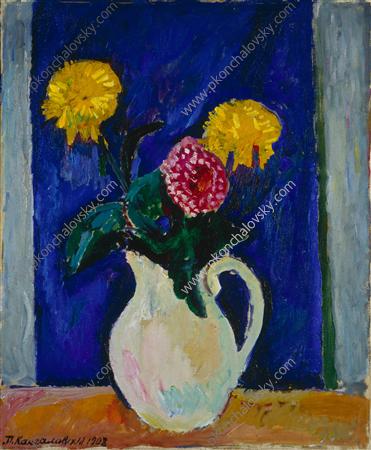Pyotr Konchalovsky, born in 1876 in the Russian village of Slavyanka, was a Russian painter. Konchalovsky’s father was a well-known literary publisher and greatly influenced his son. His father was arrested for revolutionary activities when Konchalovsky was seven years old. As a result of this, the family’s estate was seized and they were forced to move to Kharkiv. This proved to be influential in the direction the artist’s life would take.
Konchalovsky became interested in painting after attending an art school in Kharkiv at the tender age of eight. Once his father was released from prison the family moved to Moscow where his father began publishing literature once more.
He chose many well-known artists to illustrate these publications, many of whom would visit the Konchalovsky home frequently. This led to their home being a hub of art and creativity which became an important part of Konchalvsky’s upbringing. This is what ultimately led to him deciding to become an artist.
From the age of 20-22 Konchalovsky lived in Paris where he studied at the Academie Julian. This helped him to advance his skills drastically before he moved back to Moscow to study at the Academy of Arts.
In 1907, at the age of 31, Konchalovsky graduated from the Academy of Arts. Although his art was held in high praise by his contemporaries, the artist himself wasn’t satisfied with his work.
He felt his work lacked individual style. He was known for often destroying his work before it was finished due to a belief that he couldn’t create a masterpiece.
This changed when Konchalovsky visited a Van Gogh exhibition in Paris. Van Gogh’s work influenced him greatly and the artist is quoted as saying “Van Gogh gave me the understanding of painting as art”. Van Gogh’s influence would be very noticeable in Konchalovsky’s work for the next three years.
In 1909, Konchalovsky co-founded a group of artists known as the “Jack of Diamonds”. The intention of the group was to challenge societal norms by denying academic traditions. They were full of praise for post-impressionist, cubist, and Fauvist painters. In a nutshell, the group existed to oppose the traditions of society and went on to become one of the biggest groups of early Russian avant-garde.
Starting in 1909, Konchalovsky exhibited his work frequently, but it wasn’t until 1922 that he held his first solo exhibition at the Tretyakov Gallery. During this period he was painting mostly landscapes and still lifes. Like the rest of the Jack of Diamonds, his work was heavily influenced by Paul Cézanne, a French post-impressionist painter. Later on, in life, Konchalovsky began painting portraits that are considered to be in the Social Realism style.
Konchalovsky’s painting style consisted of simple compositions and details with thick colors. Many critics believe that he mixed his paints with clay instead of oil which would’ve contributed to this color thickness.
Konchalovsky avoided historical paintings, stating that he preferred to prove his patriotism in practice instead of on canvas.
Konchalovsky died in 1956.
1. Bullfighting Amateur

‘Bullfighting amateur’ was created in 1910 by Pyotr Konchalovsky in Fauvism style.
2. Portrait Of Daughter

‘Portrait of S. P. Konchalovsky with her daughter’ was created in 1916 by Pyotr Konchalovsky in Expressionism style.
3. Self-portrait

Self-portrait and portrait of Pyotr Konchalovsky are some of the artworks by Ilya Mashkov.
4. Scheherazade

‘Scheherazade’ was created in 1917 by Pyotr Konchalovsky in Fauvism style.
5. At Summer

‘At summer’ was created in 1939 by Pyotr Konchalovsky in Socialist Realism style.
6. Still Life. Currants on a sieve

‘Still Life. Currants on a sieve.’ was created in 1955 by Pyotr Konchalovsky in a Realism style.
7. Roses

‘Roses’ was created in 1955 by Pyotr Konchalovsky in a Realism style.
8. Roses and Asparagus

‘Roses and asparagus’ was created in 1955 by Pyotr Konchalovsky in a Realism style.
9. Spring Day

‘Spring Day’ was created in 1955 by Pyotr Konchalovsky in a Realism style.
10. Still Life With Flowers

‘Still Life with Flowers’ was created in 1955 by Pyotr Konchalovsky in a Realism style.
11. Jasmine Bush

‘Jasmine bush’ was created in 1955 by Pyotr Konchalovsky in a Realism style.
12. Poppies

‘Poppies’ was created in 1955 by Pyotr Konchalovsky in a Realism style.
13. Lilacs in a Purse on the Floor

‘Lilacs in a purse on the floor’ was created in 1955 by Pyotr Konchalovsky in a Realism style.
14. Gardener

‘Gardener’ was created in 1908 by Pyotr Konchalovsky in the Post-Impressionism style.
15. Girl With a Fan

‘Girl with a Fan’ was created in 1908 by Pyotr Konchalovsky in the Post-Impressionism style.
16. Girl From Arles

‘Girl from Arles’ was created in 1908 by Pyotr Konchalovsky in the Post-Impressionism style.
17. Flower in a high Vase

‘Flowers in a high vase.’ was created in 1908 by Pyotr Konchalovsky in Post-Impressionism style.
18. Study

‘Study’ was created in 1951 by Pyotr Konchalovsky in a Realism style.
19. Oranges

‘Oranges’ was created in 1908 by Pyotr Konchalovsky in the Post-Impressionism style.
20. Palm Trees and Geranium

‘Palm trees and geranium’ was created in 1908 by Pyotr Konchalovsky in the Post-Impressionism style.
21. South of France. Palma

‘South of France. Palma.’ was created in 1908 by Pyotr Konchalovsky in the Post-Impressionism style.
22. Tulips

‘Tulips’ was created in 1908 by Pyotr Konchalovsky in the Post-Impressionism style.
23. Flower Garden

‘Flower-garden’ was created in 1909 by Pyotr Konchalovsky in the Post-Impressionism style.
24. Bullfight

‘Bullfight’ was created in 1910 by Pyotr Konchalovsky in Expressionism style.
25. Grenada

‘Grenada’ was created in 1910 by Pyotr Konchalovsky in the Post-Impressionism style.


